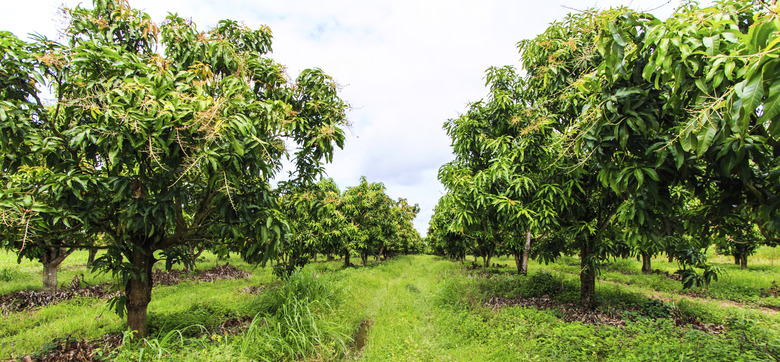Mango Tree & Its Uses
The mango tree (Mangifera indica) is a prolific producer of edible fruit, but in large yards and gardens, it can also function as a useful specimen in its own right. It can be messy, however, so its placement in the landscape needs to be carefully considered.
Mango Trees
The mango is a warm-climate tree native to the tropical and subtropical parts of south Asia. In the United States, it is winter-hardy in U.S. Department of Agriculture plant hardiness zones 10b to 11.
The tree is moderate to large in size, reaching a height of 30 to 100 feet depending on the variety and growing conditions. It has a rounded, symmetrical form, and it may develop a spreading habit, reaching a width of up to 80 feet.
The tree's lance-shaped leaves are 12 to 18 inches in length and evergreen. Its immature foliage is red, pink or pale green, but it becomes dark green as it matures.
- The mango tree (Mangifera indica) is a prolific producer of edible fruit, but in large yards and gardens, it can also function as a useful specimen in its own right.
Cultural Requirements
Mango trees prefer locations that get full sun, and they are most productive when grown in well-drained, fertile soil. They are tolerant of a range of soil pH levels, and they grow well when the soil pH is between 5.5 and 7.5.
**Young mango trees require supplemental irrigation** during dry periods, but trees older than three or four years will not need to be watered except during periods of extreme drought. Trees will produce better if they don't receive irrigation in the two months before they flower.
Mango Fruit
Mango fruits vary in size, shape and color, but in general, the fruit is oval-shaped or round, and it weighs between 1/4 pound and 5 pounds. Its color ranges from green when the fruit is immature to red, yellow, orange or purple when it's ripe. The fruit is covered in a thick, leathery skin, and its juicy inner flesh is yellow or orange when ripe. The fragrant flesh surrounds a single, large, flat seed.
- Mango trees prefer locations that get full sun, and they are most productive when grown in well-drained, fertile soil.
- Mango fruits vary in size, shape and color, but in general, the fruit is oval-shaped or round, and it weighs between 1/4 pound and 5 pounds.
- Its color ranges from green when the fruit is immature to red, yellow, orange or purple when it's ripe.
The sweet flesh of the mango tree makes it a desirable fruit crop for human consumption, and the ripe fruit in and around the tree also attracts squirrels and other wildlife.
The sap of the mango tree can be a skin irritant, and it should be washed off the fruit before the fruit is eaten.
Landscape Uses
Aside from their value as a fruit tree, mango trees can be used in the landscape as shade trees or, when planted in groups, as a hedge or a screen. The tree's fruit production, however, may be a disadvantage for its use as a landscape specimen because falling fruit will litter the ground under the tree.
Mango trees are also vulnerable to damage from lawn mowers and weed trimmers. Mulch in a 2- to 5-foot circle around the base of the tree so that grass that requires trimming doesn't grow near the trunk. A tree that's been damaged by a lawn mower or trimmer is likely to grow weak or even die.
- The sweet flesh of the mango tree makes it a desirable fruit crop for human consumption, and the ripe fruit in and around the tree also attracts squirrels and other wildlife.
- The sap of the mango tree can be a skin irritant, and it should be washed off the fruit before the fruit is eaten.
- Mango trees are also vulnerable to damage from lawn mowers and weed trimmers.
- Mulch in a 2- to 5-foot circle around the base of the tree so that grass that requires trimming doesn't grow near the trunk.
